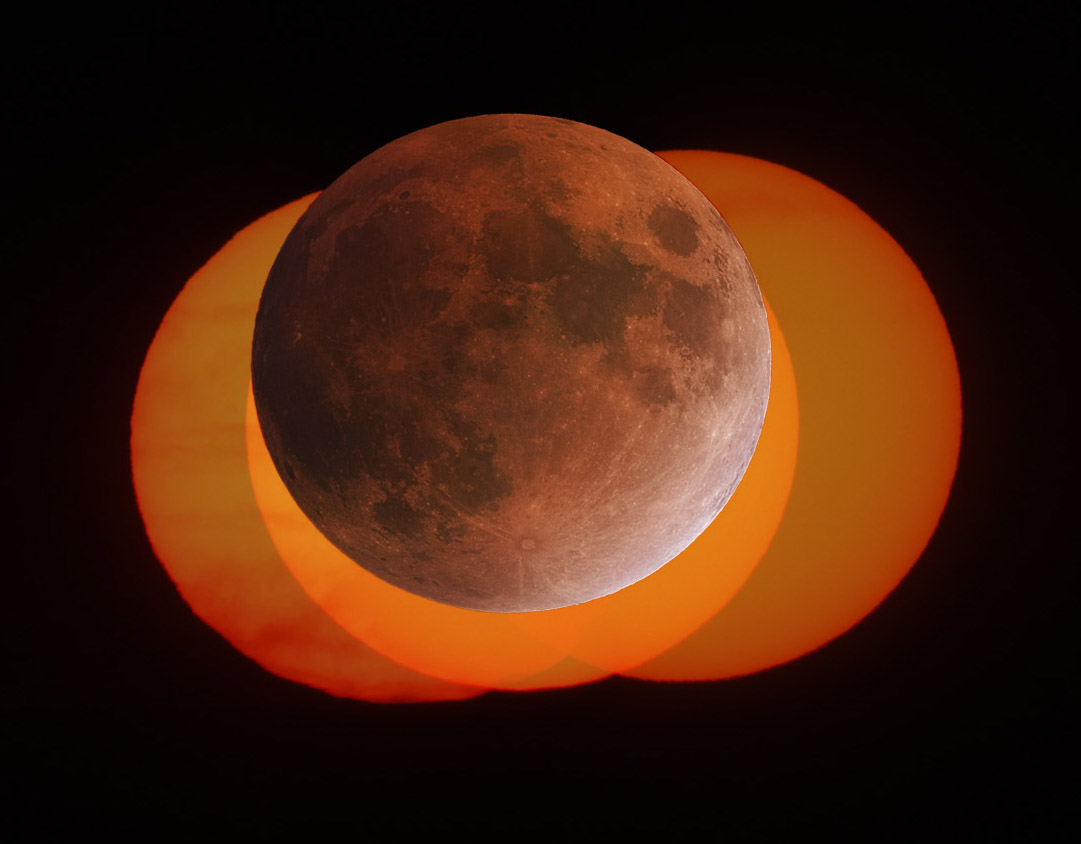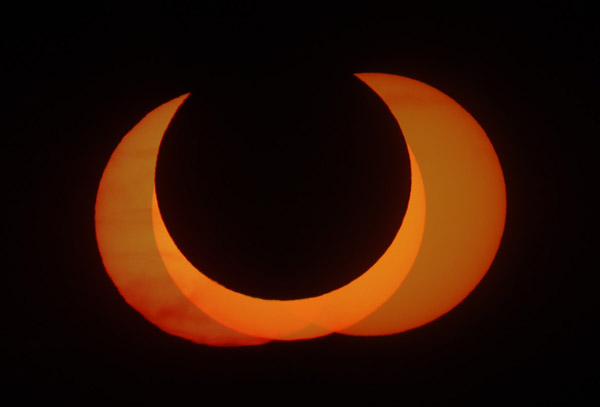Difference between revisions of "January 11, 2011"
| Line 3: | Line 3: | ||
<!-- ws:start:WikiTextHeadingRule:0:<h1> --> | <!-- ws:start:WikiTextHeadingRule:0:<h1> --> | ||
<!-- ws:start:WikiTextLocalImageRule:6:<img src="/file/view/LPOD-Jan11-11.jpg/192318980/LPOD-Jan11-11.jpg" alt="" title="" /> -->[[File:LPOD-Jan11-11.jpg|LPOD-Jan11-11.jpg]]<!-- ws:end:WikiTextLocalImageRule:6 --><br /> | <!-- ws:start:WikiTextLocalImageRule:6:<img src="/file/view/LPOD-Jan11-11.jpg/192318980/LPOD-Jan11-11.jpg" alt="" title="" /> -->[[File:LPOD-Jan11-11.jpg|LPOD-Jan11-11.jpg]]<!-- ws:end:WikiTextLocalImageRule:6 --><br /> | ||
| − | <em>solar images and composite by [mailto:rosen@pixmix.a.se | + | <em>solar images and composite by [mailto:rosen@pixmix.a.se Peter Rosén], Stockholm, Sweden, and lunar eclipse image by [mailto:j.schedler@panther-observatory.com Johannes Schedler]</em><br /> |
<br /> | <br /> | ||
During the recent partial solar [/January+6%2C+2011 eclipse] I made a composite of 3 shots (see below) taken through a telescope that together made up the outline of the new Moon. I wondered if it would be possible to find a picture of the full moon that would perfectly match the hole so I downloaded libration tables for every day since 2005 and found that on the 21st of february 2008 the Moon had a very similar libration. And to my big astonishment I remembered that there was a beautiful eclipse of the Moon on that very day! I turned to a friend who is very knowlegeable about the Moon's motion to understand if this was an extreme coincidence or part of a cycle. Well his explanations were a little beyond my understanding but in conclusion it seems to be the latter. To match 2 opposite eclipses, one of the sun and one of the moon while maintaining the same libration, a period of approximately 3 years is required.<br /> | During the recent partial solar [/January+6%2C+2011 eclipse] I made a composite of 3 shots (see below) taken through a telescope that together made up the outline of the new Moon. I wondered if it would be possible to find a picture of the full moon that would perfectly match the hole so I downloaded libration tables for every day since 2005 and found that on the 21st of february 2008 the Moon had a very similar libration. And to my big astonishment I remembered that there was a beautiful eclipse of the Moon on that very day! I turned to a friend who is very knowlegeable about the Moon's motion to understand if this was an extreme coincidence or part of a cycle. Well his explanations were a little beyond my understanding but in conclusion it seems to be the latter. To match 2 opposite eclipses, one of the sun and one of the moon while maintaining the same libration, a period of approximately 3 years is required.<br /> | ||
<br /> | <br /> | ||
| − | I then had to find a picture of the eclipsed moon of the 21st of February 2008. As it was widely photographed (but not by me) I remembered having seen a beautiful shot on Johannes Schedler's [http://panther-observatory.com/ | + | I then had to find a picture of the eclipsed moon of the 21st of February 2008. As it was widely photographed (but not by me) I remembered having seen a beautiful shot on Johannes Schedler's [http://panther-observatory.com/ site]. He gave me permission to use his picture in my composition. So I have now completed the missing face of the Moon by using an eclipsed Moon from 3 years ago, thus producing a double eclipse, only possible in the digital world. <br /> |
<br /> | <br /> | ||
| − | <em>[mailto:rosen@pixmix.a.se | + | <em>[mailto:rosen@pixmix.a.se Peter Rosén]</em><br /> |
<br /> | <br /> | ||
<!-- ws:start:WikiTextLocalImageRule:7:<img src="/file/view/LPOD-Jan11b-11.jpg/192325696/LPOD-Jan11b-11.jpg" alt="" title="" /> -->[[File:LPOD-Jan11b-11.jpg|LPOD-Jan11b-11.jpg]]<!-- ws:end:WikiTextLocalImageRule:7 --><br /> | <!-- ws:start:WikiTextLocalImageRule:7:<img src="/file/view/LPOD-Jan11b-11.jpg/192325696/LPOD-Jan11b-11.jpg" alt="" title="" /> -->[[File:LPOD-Jan11b-11.jpg|LPOD-Jan11b-11.jpg]]<!-- ws:end:WikiTextLocalImageRule:7 --><br /> | ||
Revision as of 16:29, 11 January 2015
Three Suns And Two Moons

solar images and composite by Peter Rosén, Stockholm, Sweden, and lunar eclipse image by Johannes Schedler
During the recent partial solar [/January+6%2C+2011 eclipse] I made a composite of 3 shots (see below) taken through a telescope that together made up the outline of the new Moon. I wondered if it would be possible to find a picture of the full moon that would perfectly match the hole so I downloaded libration tables for every day since 2005 and found that on the 21st of february 2008 the Moon had a very similar libration. And to my big astonishment I remembered that there was a beautiful eclipse of the Moon on that very day! I turned to a friend who is very knowlegeable about the Moon's motion to understand if this was an extreme coincidence or part of a cycle. Well his explanations were a little beyond my understanding but in conclusion it seems to be the latter. To match 2 opposite eclipses, one of the sun and one of the moon while maintaining the same libration, a period of approximately 3 years is required.
I then had to find a picture of the eclipsed moon of the 21st of February 2008. As it was widely photographed (but not by me) I remembered having seen a beautiful shot on Johannes Schedler's site. He gave me permission to use his picture in my composition. So I have now completed the missing face of the Moon by using an eclipsed Moon from 3 years ago, thus producing a double eclipse, only possible in the digital world.
Peter Rosén

Technical Details
Solar images: The eclipse of the sun started before sunrise but the sun did not emerge from behind the clouds until 8h16 UT. The 3 composited pictures of the eclipse make up a portrait of the transiting moon. Not much is missing. The first picture was taken at 8h23' UT, the second shows the crescent at the maximum of 85% at 8h41', just a little bellow the theoretical maximum of 86% visible in the north of Sweden. The 3rd picture was taken at 9h07' UT just before the clouds started coming back and completely obstructed the view a little later. I used a William Optics FLT-110 at f/6,5 with a solar filter and also a Canon Eos-40D for the eclipsed sun. To get the correct orientation of the moon, I made a simulation using Starry Night Pro Plus version 6.4.1. In making this composite I had to flatten the Moon to compensate for the atmospheric refraction of the low altitude sun, only 3.3° versus 18° for the eclipsed Moon.
Lunar eclipse image: Feb 21, 2008. TEC-140 with TEC flattener at f/7. Canon 40D: 4 x 3 sec at ISO 200 for eclipsed Moon.



